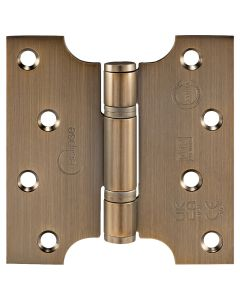Need Help? Contact Us Trade Customer? Register / Login
What Is A Parliament Hinge? A Guide to 180 Degree Projection Hinges
Parliament door hinges are essential for those looking to add both function and style to their doors. This guide provides a comprehensive look at parliament hinges, their applications and installation tips. Whether you're a seasoned professional or a DIY enthusiast, we cover everything you need to know about choosing and installing parliament hinges.
 A parliament hinge
A parliament hinge
Parliament hinges, are also referred to as projection hinges, feature extended leaves that allow doors to swing open a full 180 degrees, sitting flat against the wall. This design makes them ideal for areas where doors need to clear deep mouldings or other obstacles. Known for their robust construction, parliament hinges are a practical and stylish choice for French doors, room dividers, or any space where clearance and accessibility are essential.
Benefits of Using Parliament Hinges
- Full Door Clearance – Allows doors to open 180 degrees, sitting flush against the wall.
- Enhanced Space Utilisation – Ideal for areas where space is limited or where clearance is needed, as it maximises space.
- Added Ventilation – Excellent for creating open, airy spaces, especially with French doors.
- Architectural Elegance – Adds a refined, architectural touch to interior spaces.
Potential Drawbacks of Parliament Hinges
- Installation Complexity – Parliament hinges can be more challenging than your traditional hinges, as it requires precision with measuring.
- Higher Cost – As they are made from more material than standard hinges, so the cost can rise, especially for heavy-duty or more specialised finishes.
- Maintenance Needs – Regular lubrication and occasional adjustments may be needed to maintain smooth functionality.
Step-by-Step Guide: How to Fit Parliament Hinges
Installing parliament hinges requires precision and the right tools. Follow these steps for a secure installation:
Step 1 – Plan Your Hinges
Determine the number and placement of hinges. Generally, three hinges are recommended for doors under 2100mm in height, while taller doors may require four hinges.
Step 2 – How To Measure Hinges
Outline each hinge position on the door and frame, marking both the top and bottom edges. Carefully mark the depth to ensure a flush fit.
Step 3 – Cut Recesses for Hinges
Using a chisel and hammer, cut out the marked recesses on both the door and frame. Work slowly to avoid chipping or overcutting. Always wear safety gloves and glasses for protection.
Step 4 – Position and Drill Holes
Secure the hinges in place and drill pilot holes. These will guide the screws and help prevent splitting.
Step 5 – Attach Hinges and Test
Fasten each hinge securely, then test the door to ensure smooth movement and proper clearance. Adjust as needed.
Choosing the Right Parliament Hinges for Your Project
Parliament hinges are a great choice for doors that require wide clearance and added style, browse our collection today. Our quality hinges are made to last, ensuring both functionality and style.
Need further advice on how to choose the right door hardware? Discover our guide that delves deeper into the different types of door handles available.
Are your door handles suddenly sticking? We talk through the causes and how to fix it.
For more information about all things hinge-related or for anything ironmongery, contact us today!
